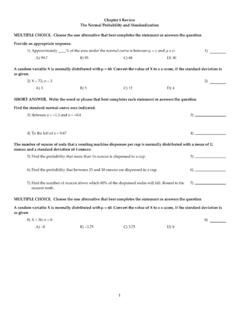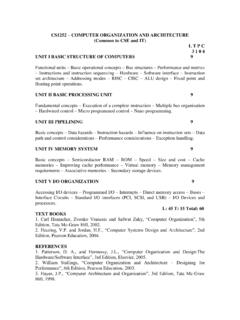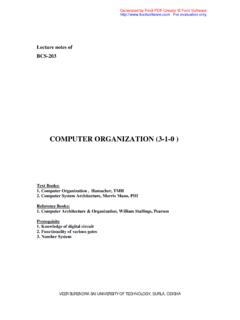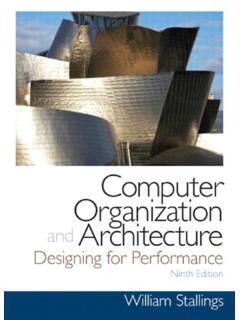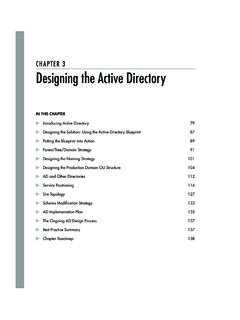Transcription of William Stallings Computer Organization and Architecture ...
1 William Stallings Computer Organization and Architecture8thEditionChapter 1 IntroductionArchitecture & Organization 1 Architecture is those attributes visible to the programmer Instruction set, number of bits used for data representation, I/O mechanisms, addressing techniques. Is there a multiply instruction? Organization is how features are implemented Control signals, interfaces, memory technology. Is there a hardware multiply unit or is it done by repeated addition? Architecture & Organization 2 All Intel x86 family share the same basic Architecture The IBM System/370 family share the same basic Architecture This gives code compatibility .. at least backwards Organization differs within members of the same family, floating point numerical co-processors with names like 8087, 80287 and 80387.
2 With very few exceptions, the 80486 and subsequent x86 processors then integrated this x87 functionality on & Function Structure is the way in which components relate to each other Function is the operation of individual components as part of the structureFunctionGeneral computerfunctions: Data processing Data storage Data movement ControlOperations (a) Data movementI/O (peripherals directly attached)Communications/Networking (communication lines)Example application?Operations (a) Data movementI/O (peripherals directly attached)Communications/Networking (communication lines)Camera attached to a PC,sending the frames to awindow on the screen of the same (b) Storage Example application?
3 Operations (b) Storage Playing an mp3 filestored in memoryto earphones attachedto the same (c) Processing from/to storage Example application?Operation (c) Processing from/to storage Any number-crunchingapplication that takes data from memory andstores the result back (d)Processing from storage to I/OExample application?Operation (d)Processing from storage to I/OReceiving packets over anetwork interface, verifyingtheir CRC, then storing themin -Top LevelComputerMain MemoryInputOutputSystemsInterconnectionP eripheralsCommunicationlinesCentralProce ssing UnitComputerStructure -The CPUC omputerArithmeticand Login UnitControlUnitInternal CPUI nterconnectionRegistersCPUI/OMemorySyste mBusCPUS tructure -The Control UnitCPUC ontrolMemoryControl Unit Registers and DecodersSequencingLoginControlUnitALUR egistersInternalBusControl UnitWilliam Stallings Computer Organization and Architecture8thEditionChapter 2 Computer Evolution and PerformanceENIAC -background Electronic Numerical Integrator And Computer Eckert and Mauchly University of Pennsylvania Trajectory tables for weapons Started 1943 Finished 1946 Too late
4 For war effort Used until 1955 ENIAC -details Decimal (not binary) 20 accumulators of 10 digits Programmed manually by switches 18,000 vacuum tubes 30 tons 15,000 square feet 140 kW power consumption 5,000 additions per secondvon Neumann/Turing Stored Program concept Main memory storing programs and data ALU operating on binary data Control unit interpreting instructions from memory and executing Input and output equipment operated by control unit Princeton Institute for Advanced Studies (IAS) Computer Completed 1952 Structure of von Neumann machineTo do in NOTEBOOK for next timeSection Know the definitions of all Key Terms Answer all review questionsSection Be able to draw the IAS/von Neumann diagram fig.
5 -details1000 x 40 bit words, each word representing One 40-bit binary number Two 20-bit instructions: 8 bits opcode 12 bits addressSet of registers (storage in CPU) Memory Buffer Register Memory Address Register Instruction Register Instruction Buffer Register Program Counter Accumulator Multiplier QuotientJohn von Neumann and the IAS machine, 1952 IAS organizationMemory Buffer Register either sends data to or receives data from Mem. or I/OControl signals are set by the opcode part of the instruction bits. Examples: Bring a new instruction from Mem. (fetch) Perform an addition (execute)Memory Address Register specifies which Mem. location will be read or written nextIAS organizationWhy do we need both a register and a buffer register to hold instructions?
6 Why does the arrow between PC and MAR point both ways?IAS organizationHint: 2 instructions are stored in each memory wordHint: the next instruction can be found either sequentially, or through a branch (jump)IAS the FETCH-EXECUTE cycleEach instruction is executed in the same two-step manner: FETCH load the binary code of the instr. from Memory (or IBR) Opcode goes into IR Address goes into MAR EXECUTE send appropriate control signals to do what the instr. needs to doIAS FETCH-EXECUTE cycleIAS instruction set ( Architecture !)There was no assembly language back then!Specifies one of 21 instructionsIAS instruction set (continued)Programming the IAS Write a program to add two numbers stored in memory at addresses 0 and 1 and store the result in memory at address 2 To do in notebook for next time: Write a program that compares the numbers stored in memory at addresses 0 and 1 and places the larger one at address 2 IAS extra-credit question (due next class)Why are there 12bits for the memory address?
7 Commercial Computers 1947 -Eckert-Mauchly Computer Corporation UNIVAC I(Universal Automatic Computer ) US Bureau of Census 1950 calculations Became part of Sperry-Rand Corporation Late 1950s -UNIVAC II Faster More memoryIBM Punched-card processing equipment 1953 -the 701 IBM s first stored program Computer Scientific calculations 1955 -the 702 Business applications Lead to 700/7000 seriesSecond generation of computers Transistors Replaced vacuum tubes Smaller Cheaper Less heat dissipation Solid State device Made from Silicon (Sand) Invented 1947 at Bell Labs by William Shockley et Based Computers NCR & RCA produced small transistor machines IBM 7000 DEC (Digital Equipment Corporation) was founded in 957 Produced PDP-1 in the same yearThird generation of computers.
8 Integrated Circuits A Computer is made up of gates, memory cells and interconnections All these can be manufactured either separately (discrete components) or on the same piece of semiconductor ( silicon wafer)Generations of Computers Vacuum tube -1946-1957 Transistor -1958-1964 Small scale integration -1965 on Up to 100 devices on a chip Medium scale integration -to 1971 100-3,000 devices on a chip Large scale integration -1971-1977 3,000 -100,000 devices on a chip Very large scale integration -1978 -1991 100,000 -100,000,000 devices on a chip Ultra large scale integration 1991 - Over 100,000,000 devices on a chipMoore s Law Increased density of components on chip Gordon Moore co-founder of Intel Number of transistors on a chip will double every year Since 1970 s development has slowed a little Number of transistors doubles every 18 months Cost of a chip has remained almost unchanged Higher packing density means shorter electrical paths, giving higher performance Smaller size gives increased flexibility Reduced power and cooling requirements Fewer interconnections increases reliabilityGrowth in CPU Transistor CountIBM 360 series 1964 Replaced (& not compatible with)
9 7000 series First planned family of computers Similar or identical instruction sets Similar or identical O/S Increasing speed Increasing number of I/O ports ( more terminals) Increased memory size Increased cost Multiplexed switch structureDEC PDP-8 1964 First minicomputer (after miniskirt!) Did not need air conditioned room Small enough to sit on a lab bench $16,000 $100k+ for IBM 360 Embedded applications & OEM BUS STRUCTUREDEC -PDP-8 Bus StructureSemiconductor Memory 1970 Fairchild Size of a single core 1 bit of magnetic core storage Holds 256 bits Non-destructive read Much faster than core Capacity approximately doubles each yearTo do for next time Read from text for next time: Ch.
10 2 until Microprocessors ( ) Take notes in notebook!1-minute Quiz What is a wordin a Computer ? ( ) Do you think the word size pertains to Computer Architecture or to Computer Organization ? Explain!1-minute Quiz The Computer industry s first plannedfamily of computers was: The Sperry-Rand UNIVAC The IBM System/360 The DEC PDP The IBM System/70001-minute Quiz What was each of these Computer s claim to fame? The Sperry-Rand UNIVAC I The IBM System/360 The DEC PDP-8 The IBM 7011-minute Quiz The text states that the latest semiconductor memories store 16 Giga-bitson a single chip (it s the binary Giga, 230) Assume that the word size is one Byte How many address lines are needed?Programming the IASW rite a program that compares the numbers stored in memory at addresses 0 and 1 and places the larger one at address 2 Programming the IASW rite a program that compares the numbers stored in memory at addresses 0 and 1 and places the larger one at address 2 Remember: In a von Neumann Architecture , both data and program are in the same memory!




